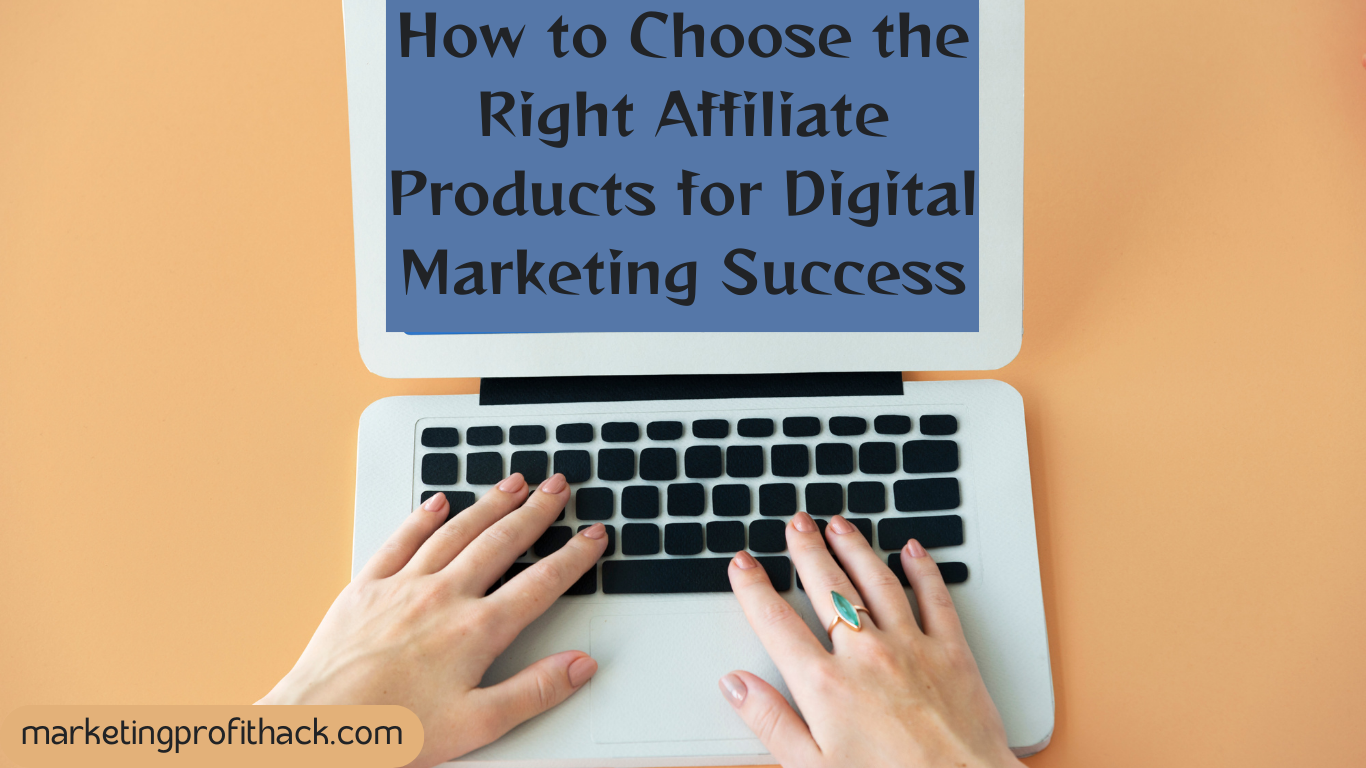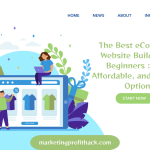Welcome to my article “How to Choose the Right Affiliate Products for Digital Marketing Success”. So, you’ve decided to dive into the world of affiliate marketing. Congrats! You’ve officially joined the ranks of digital hustlers hoping to earn commissions while sipping coffee in your pajamas. But before you start flooding your blog, Instagram, or email list with links to every product under the sun, there’s one small, slightly terrifying question you need to answer: What the heck should you promote?
Choosing the right affiliate products isn’t just about slapping a shiny banner on your website and hoping for the best. Nope. It’s more like online matchmaking—you want to pair your audience with products they’ll actually love, not ghost after clicking. Pick the wrong product, and you’ll end up with crickets (and maybe a few unsubscribes). Pick the right one, and you could be looking at a sweet stream of passive income rolling in while you binge-watch Netflix.
In this blog, we’re going to break down the art (and a bit of science) of choosing affiliate products that align with your niche, resonate with your audience, and, most importantly, convert. Whether you’re into tech gadgets, fitness programs, online courses, or cat-themed coffee mugs (hey, no judgment), there’s a right way to choose—and we’re here to help you do just that. Ready to stop guessing and start earning? Let’s dig in.
Proven Formula for $50-$100 Daily Income with 0 COST – Watch This FREE Video >>

Know Your Audience: Who Are You Really Selling To?
Before you start picking affiliate products like you’re shopping the clearance rack, take a breath. Because here’s the harsh truth: if you’re trying to sell to everyone, you’ll end up selling to no one. The foundation of successful digital affiliate marketing isn’t your link, landing page, or even your blog—it’s your audience.
🎯 Why Knowing Your Audience is Non-Negotiable
In affiliate marketing, your audience is your most valuable asset. They’re the ones reading your content, clicking your links, and hopefully swiping their credit cards. But they’ll only do that if they feel like you get them.
Think of it this way: you wouldn’t try to sell gym memberships to people looking for pizza coupons, right? (Unless it’s a “work out so you can eat more pizza” kind of brand, in which case… carry on.) Your promotions should align with your audience’s goals, challenges, and desires.
Ask yourself:
- What problems keep them up at night?
- What are they trying to achieve (make money, lose weight, save time, feel better)?
- What kind of language do they use?
- What do they already spend money on?
The better you can answer these, the sharper your targeting becomes—and your content starts to feel like it was written just for them.
🛠️ How to Get to Know Them (Without Stalking… Much)
Here’s how to dig deeper than surface-level demographics:
- Analytics Tools – Use Google Analytics, Facebook Insights, or YouTube Studio to track who’s visiting your content and how they behave. Age, location, device—they all matter.
- Surveys & Polls – Ask your email subscribers or social media followers about their pain points. Tools like Typeform or Google Forms make this easy.
- Hang Out Where They Hang Out – Lurk (politely) in niche Facebook groups, Reddit threads, Discord communities, or blog comment sections. These are goldmines for real, unfiltered audience insight.
- Email Replies & Comments – Read what your audience tells you directly. Are they confused about tools? Asking for reviews? Complaining about tech headaches? Pay attention—that’s your content strategy AND your affiliate roadmap.
📌 Bonus Tip: Create an “Audience Avatar”
This isn’t just a trendy marketing exercise—it works. Craft a fictional profile of your ideal reader:
- Name: Side Hustle Sarah
- Age: 29
- Job: 9-to-5 desk job but wants to earn passive income
- Pain Point: Tired of being broke after bills
- Goal: Earn $1K/month online without quitting her job
Now, when you’re evaluating affiliate products, ask: Would Sarah click on this? Would she trust this product enough to buy it?
The better you know your audience, the easier everything else becomes—content, product selection, email marketing, even SEO. It turns affiliate marketing from a guessing game into a strategic partnership between you, your content, and your ideal reader.
Know them. Serve them. And the commissions? They’ll follow.
Focus on Products That Solve Real Problems
Here’s a truth bomb: Nobody is browsing your blog hoping you’ll pitch them a shiny product they don’t need. In fact, in a world drowning in ads, emails, and “limited-time offers,” your audience is laser-focused on one thing: solving a problem that’s been bugging them for way too long.
If your affiliate product doesn’t clearly solve a real, tangible issue your audience cares about, you’re not marketing—you’re just shouting into the void.
🚨 The Problem-Solution Sweet Spot
The difference between a random recommendation and a money-making affiliate link is relevance. Successful digital affiliate marketers don’t promote products because they look cool. They promote products that:
- Eliminate pain (physical, emotional, financial)
- Save time or effort
- Help people reach a goal faster
- Offer peace of mind or security
- Remove friction from daily life or business
In other words, real-world value > flashy features.
Imagine your audience is full of beginner bloggers struggling to get traffic. Are they going to be interested in a luxury standing desk with LED lights? Not likely. But a course that teaches them how to drive traffic through Pinterest or a tool that automates SEO optimization? Bingo.
💡 The “Would You Buy It If You Weren’t Earning a Commission?” Test
Here’s a powerful litmus test:
Would you genuinely buy this product at full price if you weren’t getting a commission?
If the answer is no, your audience will smell that lack of authenticity from a mile away. Today’s consumers are smarter than ever. They read reviews, ask questions, and don’t fall for fluff. Recommending products you wouldn’t use yourself can damage your credibility—and once trust is gone, so are the clicks.
Instead, choose products you’d proudly recommend to a friend (the kind of friend who actually listens to you). That honesty translates into trust, and trust converts far better than hype ever could.
🛠 How to Identify Truly Problem-Solving Affiliate Products
If you’re wondering how to find these unicorns, here are a few expert tips:
- Start with Audience Pain Points
Dig into forums, blog comments, YouTube videos, and Facebook groups in your niche. What are people constantly struggling with? What’s their dream outcome? Your goal is to match those with tools, software, or solutions that directly address those issues. - Reverse-Engineer Your Own Struggles
If you once battled inconsistent income, time management issues, tech overwhelm, or burnout—you’re not alone. What helped you? Those are authentic recommendations that resonate because they’re rooted in experience. - Check for Clear Results & Case Studies
Great affiliate products often show proof of transformation. Look for testimonials, before-and-after results, or data-backed outcomes that make the benefit crystal clear. - Choose Evergreen Over Fads
Fidget spinners made a killing—for about 3 months. But tools that help people manage money, grow online businesses, build skills, or automate daily tasks? Those are forever problems with consistent search volume and buyer intent.
🤝 Be a Guide, Not a Salesperson
When you focus on solving real problems, you stop being a marketer and start being a trusted guide. You’re no longer “just promoting links”—you’re helping someone overcome a hurdle, achieve a goal, or save their sanity. That’s powerful. That’s valuable. And yes, that’s profitable too.
Remember this rule of thumb: If your affiliate product feels like a natural, helpful step forward in your reader’s journey, you’re on the right track. Anything else is just noise—and we’ve got enough of that already.
Proven Formula for $50-$100 Daily Income with 0 COST – Watch This FREE Video >>
Absolutely — let’s go deeper and make it even more powerful, strategic, and SEO-optimized, while keeping the informative style with some wit intact.
Evaluate the Commission Structure and Earning Potential (Like Your Income Depends on It… Because It Does)
Here’s the deal: If affiliate marketing is your online hustle, the commission structure is your paycheck, and it deserves the same scrutiny you’d give a new job offer — maybe even more. You wouldn’t take a job that pays pennies per hour with no benefits, right? (Unless you’re into heartbreak and instant ramen for dinner.)
The truth is, not all affiliate programs are built equally. Some are built for creators to thrive, while others are built like mazes — confusing, low-paying, and designed to benefit everyone except you. So, before you go plastering affiliate links all over your blog or YouTube channel, let’s break down the real money talk.
💸 Understand the Commission Types (And Why They Matter)
There are a few ways affiliate programs compensate you, and knowing the difference is critical:
1. One-Time Commissions
You refer a sale, and boom — you get paid once. This is common in physical products and some digital courses. It’s great for short-term cash, but the faucet stops once the sale is done.
Example: Promote a $200 course at a 40% commission rate = $80 per sale. Nice chunk of change upfront, but that’s the end of the road.
2. Recurring Commissions (Passive Income Goldmine)
This is the affiliate marketer’s dream. You refer a customer to a subscription-based service (like software or membership sites), and you get paid every month they stick around.
Example: Promote a $49/month tool with 30% recurring commissions = ~$15/month per customer. Now imagine 100 customers. See the snowball effect?
3. Tiered or Backend Commissions
Some programs reward you not just for direct referrals, but also for backend sales (upsells, cross-sells, etc.) or even team performance in multi-tier setups.
Example: A referred customer buys a low-cost item today, then a premium upgrade 3 months later. If you’re in a good program, you’ll earn on both.
📈 Look Beyond the Rate: Evaluate the Real Earning Potential
A 50% commission might sound amazing—until you realize it’s 50% of $10. (Congrats, here’s your $5. Don’t spend it all on one app download.)
To really know if a product is worth promoting, consider:
- Product price x commission rate = real money
- Conversion rate: How well does the sales page convert traffic into buyers?
- Cookie duration: How long after someone clicks your link can you still earn a commission?
- Lifetime value of the customer (LTV): Are there upsells or renewals that make one referral worth more over time?
Pro tip: A product with a 10% commission but a $1,000 price tag and strong conversion rate might outperform a 50% commission on a $20 ebook that barely sells.
🚨 Commission Red Flags You Shouldn’t Ignore
Not every affiliate program is designed with your success in mind. Here are signs you might be wasting your time:
- 💀 Low commission rates (think 1–3%) unless you’re moving serious volume
- ⏳ Short cookie durations (24–48 hours? Might as well play roulette)
- 🧩 No clarity on the payment process or dashboard (if you don’t know where the money’s going, it’s probably not going to you)
- 🥴 Complex or sketchy payout terms like minimum thresholds or delayed payments
🤝 Strike the Balance: High Commissions vs. Audience Fit
Let’s be real: You could promote a $2,000 course with 50% commission and earn $1,000 a pop. Sounds dreamy, right? But if your audience is full of beginners with tiny budgets, they’re not buying that course. So what do you earn? Zip. Nada. Nothin’.
Instead, find products that:
- Are priced within your audience’s budget
- Deliver real value (as covered in earlier sections)
- Still offer solid commissions (ideally 25–50% for digital or recurring for tools/subscriptions)
✅ Final Thought: Run the Numbers, Then Run With It
Before you go promoting any affiliate product, ask yourself:
- How much do I earn per sale?
- How often can I realistically make those sales?
- Is this income sustainable or scalable?
When you evaluate affiliate programs like a business owner—not just a promoter—you start to see the compound potential of smart choices. One well-aligned product with recurring commissions can outperform ten random links.
So don’t just grab affiliate links like candy on Halloween. Choose like your freedom depends on it. Because for many successful affiliate marketers, it absolutely does.
Proven Formula for $50-$100 Daily Income with 0 COST – Watch This FREE Video >>
Absolutely! Here’s a deep and engaging expansion of the topic “Trust and Quality: Promote Products You’d Use Yourself”, keeping the same informative, slightly witty tone that balances SEO value and real-world advice:
Trust and Quality: Promote Products You’d Use Yourself (And Not Just for the Commission)
Let’s face it — affiliate marketing can sometimes feel like a tempting buffet of high-commission goodies. But here’s the golden rule that separates the one-hit wonders from the long-term earners: if you wouldn’t use the product yourself, don’t expect your audience to trust you when you recommend it.
Think of affiliate marketing like matchmaking. You’re not just pushing a link — you’re setting your audience up with a product or service and saying, “Hey, I think you two will really hit it off.” Now imagine doing that with something you secretly think is terrible. That’s how reputations get ruined and trust goes out the window faster than you can say “unsubscribe.”
🧼 Your Reputation Is Your ROI
When people follow your blog, your YouTube channel, or your late-night tweets, they’re not just looking for information — they’re trusting you to curate the internet on their behalf. Your recommendations carry weight. If your audience buys a product based on your suggestion and it turns out to be trash, guess who they’ll blame? Yep. You.
But if you consistently recommend high-quality, reliable, and genuinely useful tools, people will start to see you as a trusted authority — and that’s where the magic happens. You build loyal fans who actually click your links again and again.
💡 Pro tip: Ask yourself, “Would I feel good telling my best friend to buy this?” If the answer’s “ehhh,” back away slowly.
🧪 Test It Before You Pitch It
Whenever possible, use the product first. Sign up for the tool. Try the course. Drink the weird health shake (okay, maybe just one sip). There’s nothing more powerful than speaking from personal experience.
- You can highlight real benefits that generic reviews miss.
- You can walk your audience through setup, usage, or results.
- You can answer actual objections because, hey — you’ve been there.
And if the product turns out to be awful? Congrats — you just dodged a bullet and protected your audience.
🏆 Quality Over Commission, Always
It’s tempting to promote the highest-paying affiliate offer in your niche. We’ve all seen that $997 course with a 50% commission waving at us like a dollar-filled mirage in the desert. But here’s the truth: a high-paying scam is still a scam. And recommending junk just because it pays well will tank your credibility faster than a TikTok trend dies.
Focus on:
- Products with positive reviews and testimonials
- Tools with responsive support and frequent updates
- Brands that actually care about their customers, not just conversions
If you build your affiliate strategy on integrity, your followers will notice. They’ll trust you, respect you, and — surprise — they’ll actually buy more.
🎯 Long-Term Wins Come from Long-Term Trust
Trust isn’t built in a day, but it can be destroyed in one. And in a world where consumers are more skeptical than ever, promoting a quality product you’ve used (or fully researched) is your best weapon.
Because when someone says, “I bought this because you recommended it — and I love it,” that’s not just a sale. That’s a relationship. And in affiliate marketing, relationships are what drive repeat clicks, shares, and long-term income.
So remember: promote the products you’d proudly use yourself — not just the ones that dangle shiny commissions. You’re not just an affiliate. You’re a guide, a recommender, a digital trust-builder. And that’s a role worth taking seriously (with just a sprinkle of humor, of course).
Absolutely! Here’s a deep, witty, and SEO-friendly expansion of “Match the Product with Your Content Strategy” — keeping that same informative tone with a dash of humor and clarity:
Match the Product with Your Content Strategy (Because Random Links Won’t Make You Rich)
Let’s be honest: spraying affiliate links across your content like confetti at a New Year’s party might feel festive, but it’s not a strategy — it’s a mess. If you want real results in affiliate marketing (read: actual commissions), you need to promote products that make sense within your content strategy.
In other words, if your blog is about minimalist living, don’t suddenly start pushing high-end espresso machines unless they fold into a drawer and whisper affirmations while brewing. The product has to fit your content like guac fits tacos — naturally, irresistibly, and without feeling forced.
🎯 Why Relevance Is the Real King (Sorry, Content)
“Content is king” gets all the glory, but relevance is the secret ruler behind the scenes. Your audience didn’t land on your blog, YouTube channel, or TikTok feed by accident. They’re there for a reason — maybe to solve a problem, learn something new, or just stalk your tool recommendations (hey, it happens).
If the affiliate product you’re promoting directly supports that journey, it becomes a no-brainer for your audience to click and buy. If not, it’s like offering someone a gym membership at a donut shop — confusing at best, suspicious at worst.
Examples:
- Teaching SEO? Recommend keyword research tools or hosting platforms.
- Running a food blog? Suggest kitchen gear or niche recipe ebooks.
- Sharing freelance tips? Point to invoicing tools or online course platforms.
🧩 Integrate, Don’t Interrupt
A smart affiliate product doesn’t just sit on the page like an awkward ad — it flows with the content. The more naturally it blends in, the higher your chances of conversion.
Try these integration ideas:
- Tutorials: “How I used [Tool X] to grow my email list by 300%”
- Comparisons: “Best Budget vs. Premium Tools for [Your Niche]”
- Case studies: “How I Made $1,000 Using This Affiliate Program”
- Resources pages: A dedicated “Tools I Use & Recommend” section
Done right, your content becomes both educational and monetizable, without sounding like a pushy salesperson.
🧠 Plan Products Around Pillar Content (Not the Other Way Around)
If your entire content plan revolves around squeezing in random affiliate links, your readers will feel it — and bounce. Instead, build your core content (also known as pillar posts) around genuine audience needs, then strategically plug in products that solve those needs.
Let your content lead. The affiliate products should feel like a helpful sidekick, not the main character demanding attention.
💬 Consistency Builds Trust, and Trust Builds Sales
If your audience knows that your content always brings value and the products you mention are genuinely helpful, they’ll stop treating your affiliate links like ads. Instead, they’ll treat them like personal recommendations from a friend — the kind of friend who’s done all the research so they don’t have to.
Stick to your niche, match your content tone, and keep your product suggestions aligned with what your audience already expects from you. That’s how you win in the long game of affiliate marketing.
✅ Final Thought: Strategy Over Scatter
Affiliate success isn’t about how many links you post — it’s about how strategically you place them. When your affiliate products and your content strategy are singing the same tune, conversions happen naturally. No tricks. No gimmicks. Just useful content, smart product placement, and long-term trust.
So don’t just throw spaghetti (or affiliate links) at the wall. Serve a five-star meal — perfectly matched content with products that actually help your audience. Bon appétit, marketer.
Absolutely! Here’s a well-rounded and engaging Conclusion section for your article “How to Choose the Right Affiliate Products for Digital Marketing Success”, written in the same informative style with a touch of humor:
Conclusion: Choose Smart, Sell Smart, Sleep Better
At the end of the affiliate marketing day (or endless hustle-fueled night), your success doesn’t just hinge on how many products you promote — it hinges on what you promote and why.
Choosing the right affiliate product isn’t a guessing game or a game of “who pays the biggest commission.” It’s about aligning your audience’s needs with trustworthy, high-quality solutions — and yes, making sure you actually get paid in the process.
Here’s your cheat sheet in case you’ve been speed-scrolling:
- Know your audience like you know your favorite meme template.
- Promote solutions, not just stuff — people want fixes, not fluff.
- Understand the commission structure like it’s your paycheck (because it is).
- Only recommend products you’d proudly use (no selling your soul for $4.99).
- And finally, make sure the brand has your back with solid support and resources.
Affiliate marketing done right feels less like sales and more like service — you’re genuinely helping people while building an income stream that can scale with time and trust.
So take your time. Research smart. And above all, choose products that make you think, “Yes, this is awesome — my audience is going to love this.”
Because when you pick the right products, the right audience, and the right mindset? That’s not just affiliate marketing. That’s digital success done right.
Proven Formula for $50-$100 Daily Income with 0 COST – Watch This FREE Video >>
Thanks a lot for reading my article on “How to Choose the Right Affiliate Products for Digital Marketing Success“ till the end. Hope you’ve helped. See you with another article.










